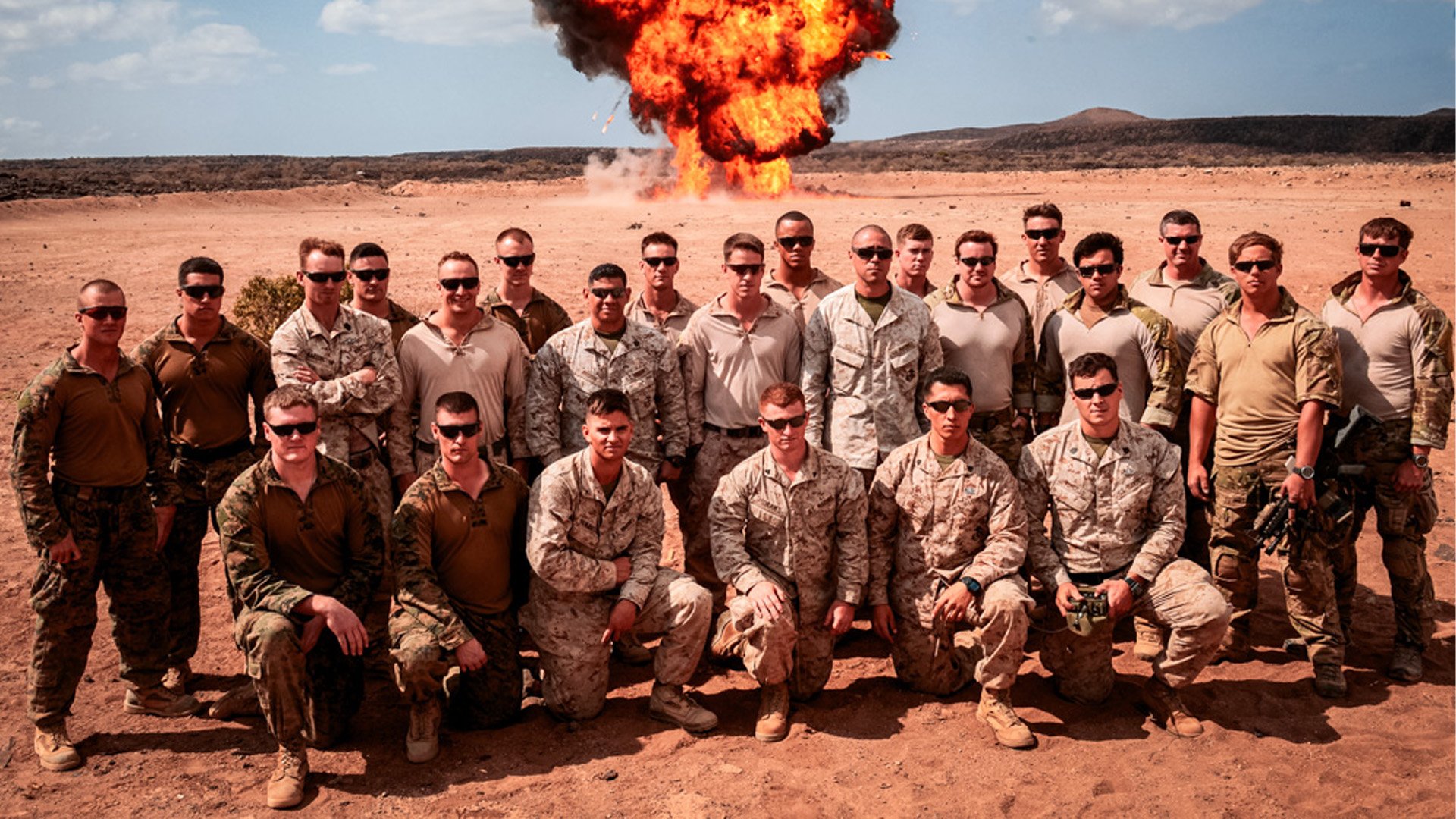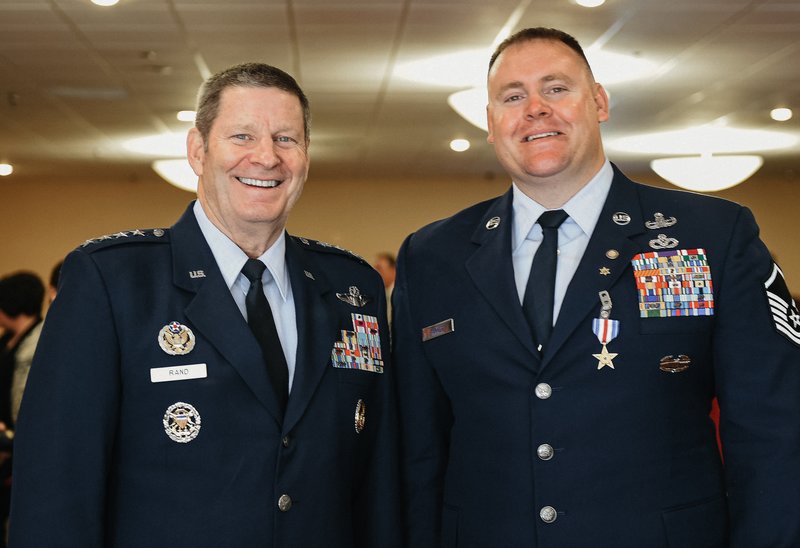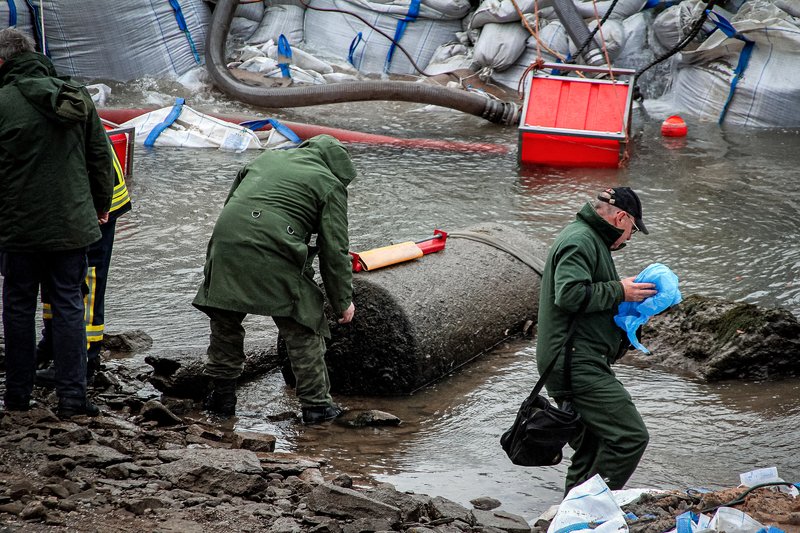EOD: A History of Explosive Ordnance Disposal From World War II to Today

Group photo of US Marine Corps and Navy service members as their last detonation explodes at the conclusion of advanced joint explosive demolition training at Arta Range Complex, Djibouti, Dec. 30, 2013. US Air Force photo by Senior Airman Tabatha Zarrella
On May 21, 2014, an assault force made up of soldiers from the US Army’s 82nd Airborne Division and members of the Afghan Border Police embarked on a clearing mission in a mountainous area of Kandahar Province.
Their objective was an insurgent bomb-making factory hidden inside a cave. The Afghan police officers, descending the mountain ahead of their American comrades, reached the cave first and found it occupied by enemy fighters. A gun battle erupted.
The Americans called for close-air support before advancing into the fray. Technical Sgt. Kristopher Parker, an Air Force team leader and bomb technician assigned to the 466th Explosive Ordnance Disposal Flight, destroyed four bomb caches along the route leading to the mouth of the cave. Then his EOD team came under heavy enemy fire.

Retired US Air Force Master Sgt. Kristopher Parker, right, was presented the Silver Star by Gen. Robin Rand, commander of Air Force Global Strike Command March 17, 2017, at Dyess Air Force Base, Texas. US Air Force photo by Airman 1st Class Emily Copeland.
The fighting intensified. Hours into the mission, another round of airstrikes was called in before the assault force made its third attempt to penetrate the enemy stronghold. Parker and his EOD team were nearing the cave’s entrance when an Army officer they were with was struck by gunfire. A barrage of rocket-propelled grenades and a hand-thrown improvised explosive device (IED) followed, exploding within 3 meters of their position.
The blast threw Parker and his comrades to the ground and left them dazed with severe concussions. Yet Parker persevered, using his M4 rifle to lay down suppressive fire and keep the insurgents at bay. His radio lost, another soldier called and submitted the 9-line medevac request for the wounded officer while Parker helped clear the landing zone of IEDs.
Finally, after more than 20 hours of sustained combat, Parker’s team withdrew from the objective. All of them survived. As a result of his actions that day, Parker would later be awarded a Silver Star.
Related: That Time a Cow Blocked the Path of Two EOD Techs With 16 Pounds of C-4
The Birth of EOD

Disposal of a British 4,000-pound blockbuster bomb dropped by the RAF during World War II. Found in the Rhine near Koblenz on Dec. 4, 2011. Wikimedia Commons photo.
Although armies have used explosives for centuries, dedicated bomb disposal specialists didn’t exist until World War II.
On Sept. 7, 1940, Nazi Germany conducted a massive bombing raid on London, dropping approximately 337 tons of ordnance in a single day. The bombs that detonated killed 448 civilians.
After the dust settled, thousands of live bombs were found scattered across London. The vast amount of unexploded ordnance (UXB) posed a significant threat to the city’s residents. To deal with the problem, the British military created its first mine and bomb disposal units.

Boilerman First Class Paul C. MC. Craw, left, and Mine man Third Class Ralph E. Loux examine a Viet Cong mine that was disarmed by a member of the six-man bomb squad assigned to the US Naval support activity, Saigon, Republic of Vietnam. Photo courtesy of the US Naval History & Heritage Command.
The first generation of British bomb techs performed their duties without protective suits. Much of the Nazi ordnance they had to deal with were rigged with delayed time fuses, so rather than explode upon impact with the ground, the bombs would often detonate while being dismantled. According to the National Explosive Ordnance Disposal Association, approximately 389 bomb disposal technicians lost their lives in the war.
In 1942, the US Navy and US Army developed their own EOD training pipeline. The first instructors were British. Their American pupils then became the instructors who taught the teams that were eventually deployed overseas. By the war’s end, Allied EOD techs disposed of 45,441 unexploded bombs, 6,983 anti-aircraft shells, and more than 300,000 mines.
Related: UDT Shorts, Silkies, and Ranger Panties: A Risqué Military Fashion Trend
Is EOD Considered Special Operations?

Explosive ordnance disposal Marines from Marine Wing Support Squadron 274 destroy an improvised explosive device cache found by Marines from Lima Company, 3rd Battalion, 3rd Marine Regiment, in an abandoned compound east of their newly established observation post in Southern Shorsurak, Helmand province, Afghanistan, during Operation New Dawn, June 20, 2010. Wikimedia Commons photo.
Every branch of the US military — yes, even the Space Force — has dedicated EOD teams. The Army, Navy, Air Force, and Marine Corps bomb techs are considered special operations.
The Army currently has two teams directly supporting special mission units. They are the 21st Ordnance Company (EOD WMD) and the 28th EOD Company (Airborne). Both were established with the help of Dennis Wolfe, one of the two original EOD techs of the Army’s elite Delta Force, who continued to work with SOCOM as a civilian contractor after he retired in 1987, at the rank of sergeant major.
The 21st EOD WMD was established in 1998 in response to the growing threat of improvised nuclear and radiological dispersal devices. A little more than a decade later, the 28th EOD Company was created to support the Green Berets and the 75th Ranger Regiment. Both EOD units fall under the 20th Chemical, Biological, Radiological, Nuclear, Explosives (CBRNE) Command.

Chief Explosive Ordnance Disposal Technician Evan Bruce, assigned to Explosive Ordnance Disposal Training and Evaluation Unit (EODTEU) 1, jumps from a KC-130 aircraft during the parachute phase of the Maritime Insertion Course run by EODTEU-1 in San Diego, July 29, 2021. US Navy photo by Petty Officer 2nd Class Jason Isaacs.
The Navy’s EOD technicians belong to the Naval Special Warfare/Naval Special Operations. About 2,500 sailors within Navy EOD are assigned to either EOD Group One, EOD Group Two, or Expeditionary Exploitation Unit One. Their mission sets include combat operations alongside SEALs and Army Special Forces, underwater mine clearance in support of the fleet, and even the disposal of weapons of mass destruction.
Navy EOD technicians can also try out for the Navy’s special missions unit, known as the Naval Special Warfare Development Group, or DEVGRU. If selected, they are assigned to a squadron to support the unit’s counterterrorism operations.
Air Force bomb techs are not considered part of Air Force Special Warfare (PJs, CCTs, SR). However, they are considered Combat Support, which provides unique specialties to conventional and special operations units.
In the Marine Corps, individuals must complete the 10-week Marine Special Operations Forces Explosive Ordnance Disposal Level 1 Course to become Fleet Marine Force Explosive Ordnance Disposal Technicians. Qualified Marine EOD techs are eligible to support either the US Special Operations Command (SOCOM) or the Marine Forces Special Operations Command (MARSOC).
Related: From Military to Public Service, Johnny Joey Jones Is a Voice for Veterans
Robots and Bomb Suits

The Wheelbarrow remotely controlled bomb disposal tool developed during the Troubles conflict in Northern Ireland in the 1970s. Wikimedia Commons photo.
EOD technicians use various tools and equipment to safely neutralize explosive hazards in the field. The most utilized include bomb suits and remote-controlled robots, a technology first developed by the British Royal Army Ordnance Corps at the height of the Troubles in Northern Ireland.
In 1972, British ordnance disposal teams used the so-called “Wheelbarrow” robot to safely disarm car bombs planted by the Irish Republican Army. The four-wheeled, electrically driven robot featured a camera, a scissors clamp, and a “pigstick” that fired a stream of water to fry the bomb’s circuitry. According to The Times, the Wheelbarrow was deployed more than 400 times in Northern Ireland and saved many lives. British EOD techs also wore primitive bomb suits for added protection.
Bomb disposal technologies underwent their most significant advancements in the aftermath of the Sept. 11 terror attacks. The proliferation of IEDs in Iraq, Afghanistan, and other War on Terror combat zones required the British and Americans to develop better protective suits and bomb detection tools.

An EOD technician wearing a protective bomb suit inspects an explosive device. Wikimedia Commons photo.
The bomb suits of today are bulky and cumbersome, typically weighing about 85 pounds. The MED-Eng EOD 10 Bomb Suit is the most widely used version in the world, worn by bomb techs from more than 60 countries. The suit provides full body protection, complete with a helmet and blast-proof footwear.
Additionally, to address the threat of heat stress that has long plagued EOD techs, the MED-Eng EOD 10 Bomb Suit features an enhanced ventilation system. The suit is also equipped with an integrated voice command system, allowing for hands-free communication.
Over the past 20 or so years, US Air Force bomb technicians alone have conducted a staggering 19,000 missions in Afghanistan and another 36,000 in Iraq. Between 2001 and 2013, 20 EOD airmen were killed in the line of duty and upwards of 115 more were wounded. Tragic as those numbers are, without the recent improvements in ordnance disposal technology, it is very likely they would be much higher.
Read Next: EOD Captain Breaks Bomb Suit 1-Mile Run World Record
This article has been updated to reflect that Air Force bomb technicians are, in fact, considered special operations forces.

Matt Fratus is a history staff writer for Coffee or Die. He prides himself on uncovering the most fascinating tales of history by sharing them through any means of engaging storytelling. He writes for his micro-blog @LateNightHistory on Instagram, where he shares the story behind the image. He is also the host of the Late Night History podcast. When not writing about history, Matt enjoys volunteering for One More Wave and rooting for Boston sports teams.
BRCC and Bad Moon Print Press team up for an exclusive, limited-edition T-shirt design!
BRCC partners with Team Room Design for an exclusive T-shirt release!
Thirty Seconds Out has partnered with BRCC for an exclusive shirt design invoking the God of Winter.
Lucas O'Hara of Grizzly Forge has teamed up with BRCC for a badass, exclusive Shirt Club T-shirt design featuring his most popular knife and tiomahawk.
Coffee or Die sits down with one of the graphic designers behind Black Rifle Coffee's signature look and vibe.
Biden will award the Medal of Honor to a Vietnam War Army helicopter pilot who risked his life to save a reconnaissance team from almost certain death.
Ever wonder how much Jack Mandaville would f*ck sh*t up if he went back in time? The American Revolution didn't even see him coming.
A nearly 200-year-old West Point time capsule that at first appeared to yield little more than dust contains hidden treasure, the US Military Academy said.












